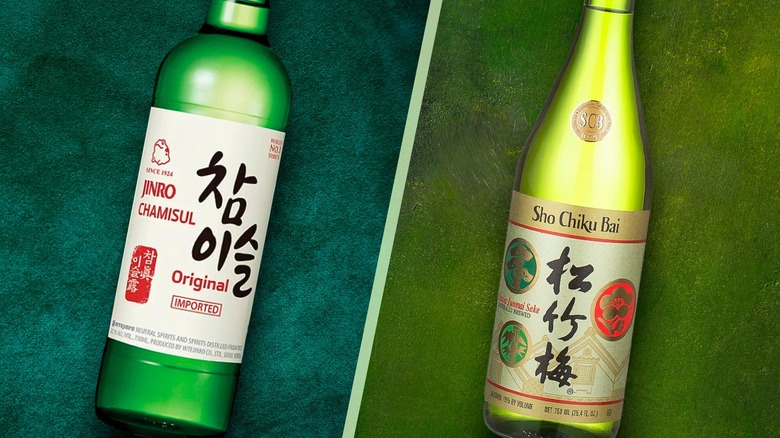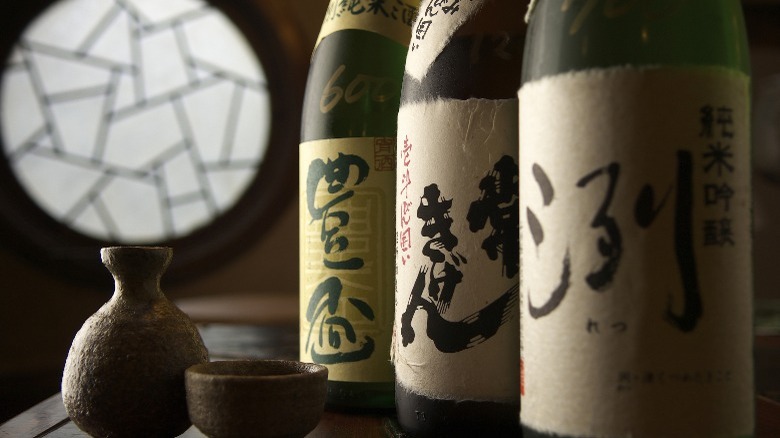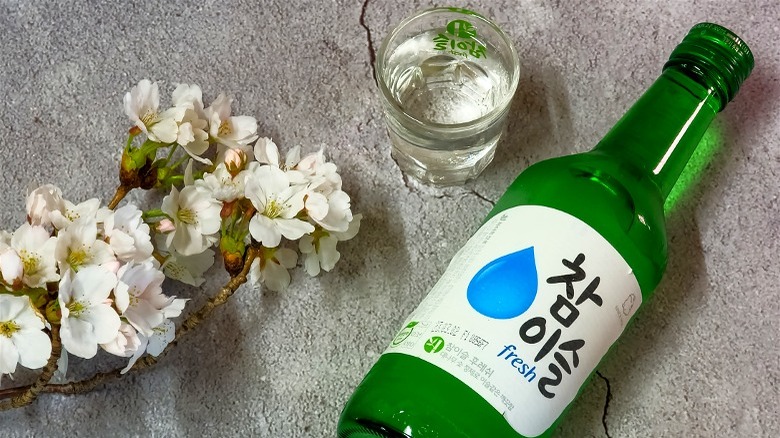What Makes Soju Different From Sake?
If you're shopping for liquor, there's going to be a section full of colored bottles with inky illustrations and scripts in another language glistening on the shelf — the section where most liquor stores put together the alcohol from Eastern Asia. But where to begin? Firstly, read the label to make sure you know what you're getting, because it would be a mistake to mix up soju and sake.
Soju, which often comes in a small green bottle with a twistable cap, is a distilled Korean liquor. Best served chilled, people drink it straight as a shot, or sip on it over time in a glass, though plenty of folks might just sip through the whole bottle in a night. Sake is a rice-based Japanese brewed drink more akin to beer and wine. What may surprise people who aren't familiar with this beverage is how it's served. Sake will often be delivered to your table warm at a restaurant, but this is not a hard rule. Soju is also a neutral, sweet drink that can have a higher alcohol content, while sake has a more umami taste. Both drinks have rich cultures, tastes, and creation processes that make them distinct from each other.
Sake is always fermented from rice
Sake is produced from polished rice that's been washed, soaked, and steamed so that it's ready to host a mold called koji. Sake brewers add koji because yeast, an ingredient used in fermentation, can't digest starch without the help of the koji's enzymes, which convert the starch to sugar. Fermented yeast plus sugar equals alcohol, and the use of rice adds a special umami flavor. Once it's finished brewing, the average alcohol content for sake is 13 to 17%.
Sake is also a common drink to pair with food, similar to wine, and you can find it served in Japanese steakhouses – though if you're ordering in Japan, you should keep in mind that the true name of this drink is nihonshu. In Japanese, the word sake simply means "alcohol." Whatever you call it though, sake goes well with cheese and seafood, and it can be used for cooking meat and rice. The umami quality of the drink is why recipes will call for its use, so don't try substituting it with a sweeter alcohol like soju. And when you order sake at a restaurant, expect it to come in a small ceramic or porcelain bowl-shaped cup along with a bigger bottle to pour from. It's also good etiquette to offer to pour someone else a drink before serving yourself.
Soju is a distilled liquor with a sweet side
Soju can be made with rice, but it also has a history of being made with tapioca, sweet potato, wheat, or barley. It's a clear beverage, and because it's distilled, it's a gluten-free liquor like vodka or rum. While sake may be flavored with yuzu or plum, common soju flavors include peach, green grape, and yogurt.
Popular soju brands like Jinro, Soon Hari, and Good Day sell flavored soju in iconic green bottles, with an alcohol content of around 13 to 16%. However, traditional, neutral soju can have a much higher ABV, typically around 20 but sometimes as high as 45%. Distilled liquor often contains more alcohol than brewed drinks like sake. People drink soju for its neutral or fruity tastes, making it a great cocktail mixer, though it can also be used in cooking – soju makes a great secret ingredient for chicken soup. As a drink, it's not hard to lose pace with a sweet, smooth drink you can handle without any other mixers, making it popular among college students.
Soju, the most consumed alcohol in Korea, may not be the world's cheapest liquor, but you can find a small bottle for around $6 at many liquor retailers. A typical sake, meanwhile, might cost over $15, while a premium sake might cost much more. Expand your horizons by tasting both soju and sake, to make sure you don't end up disappointed from mistaking one for the other.


